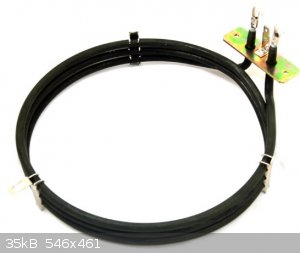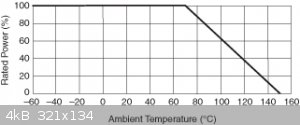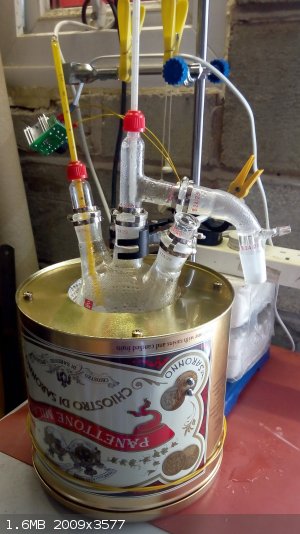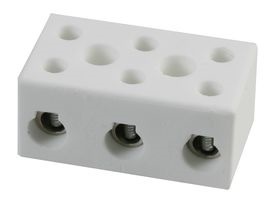Sulaiman
International Hazard
    
Posts: 3558
Registered: 8-2-2015
Location: 3rd rock from the sun
Member Is Offline
|
|
SA Heater & Stirrer (Blog)
I need heating and stirring for my planned distillation rig.
I have decided to do-it-myself,
and use SM to host my construction blog and relevant Q&A.
I intend to build the stirrer and heating sections separate but stackable
with some provision for raising/lowering the assembly.
The heater must accomodate 500 ml R.B.F.s,
with the option of smaller, and possibly larger flasks.
I would like to be able to get up to 500 Watts into a 500 ml R.B.F. (?)
Plan A for the heater is based around one or two 'Fan Oven Heating Element' 220 V 2200 W
(ordered 2 for £7.82 total, eBay UK)

Outside diameter of heating coils c190mm, other dimensions to be measured on arrival.
I could use one (more than enough power) in the design and keep one as a spare,
Or use both in electrical series for 1.1 kW max with a larger area ... t.b.d.
This type of heating should allow the flask to be as near as practical to the stirrer for good magnetic coupling.
So, before I start ... any comments
CAUTION : Hobby Chemist, not Professional or even Amateur
|
|
|
Harristotle
Hazard to Others
  
Posts: 138
Registered: 30-10-2011
Location: Tinkerville
Member Is Offline
Mood: I tink therefore I am
|
|
Hi.
If you have two elements in series, you will half your power, not double it. (Parallel will double watage)
mathematically:
power = volts * current
current = volts/ resistance (from Ohms law)
So the resistance of your heater can be found by rearranging
power = volts * volts / resistance.
R = 220V^2/500W
=96.8 ohms.
If you put two resistances in series, you add their resistance together (double it).
so P = (220V^2/(193.6) = 250W.
Other thoughts: I am not sure I like the low surface area contact of your heating element. It means your flask will have parts in contact strongly
heated, and most of it not strongly heated. This may encourage it to crack, if it is damaged/flawed.
There are some good threads here on making your own from refractory (fireplace) cement and nichrome wire - eg http://www.sciencemadness.org/talk/viewthread.php?tid=4190
That would be a good place to start.
|
|
|
Sulaiman
International Hazard
    
Posts: 3558
Registered: 8-2-2015
Location: 3rd rock from the sun
Member Is Offline
|
|
Thanks, but I guess you missed it, 2200 W elements, two in series for 1.1 kW
and the heating coils, being c190mm diameter, will be well clear of a 100mm dia. 500ml rbf.
probably enough space for a sand/oil/water bath to fit of required 
My initial concerns are with radiative heating (/hot air bath) ... will it work for most things that I may want to distill ?
Will I need a fan in the heater space ?
but I guess that in a couple of days I can find out 
[Edited on 7-1-2017 by Sulaiman]
CAUTION : Hobby Chemist, not Professional or even Amateur
|
|
|
Dr.Bob
International Hazard
    
Posts: 2656
Registered: 26-1-2011
Location: USA - NC
Member Is Offline
Mood: No Mood
|
|
That is way more watts than most standard heating mantles, so you will need to be careful to use a low setting on whatever power controller you use or
the heat will heat very fast and be dangerous with flammable solvents. You might want to either use an aluminum hemisphere or block to spread the
heat better. But the idea seams fine, just need to make sure you don't over heat the target rbf. Few fans will survive that heat, might need to
fine some inert conductive material to help, however.
|
|
|
Sulaiman
International Hazard
    
Posts: 3558
Registered: 8-2-2015
Location: 3rd rock from the sun
Member Is Offline
|
|
IF a fan is required I imagine motor and fanblades separated by some sort of heat shield / the wall.
My next mini-quest is to find common, cheap, thin, strong, heatproof, non-magnetic, heat-reflecting sheets for top and bottom.
equivalent to asbestos sheet.
the prototype will use gypsum/drywall, or metal, or whatever is nearby ... just for testing radiative heating.
I agree about the power, I bought the heating coils on impulse
... looked possible, easy, rugged, easily replaced, and most importantly, on offer ...
I will initially use a zero-crossing-switching 40A SSR with pulse width modulation 0 to X% at about 1 Hz
... where X will normally be much less than 33 ... but one has to test, right 
may even try some toast ...
CAUTION : Hobby Chemist, not Professional or even Amateur
|
|
|
aga
Forum Drunkard
    
Posts: 7030
Registered: 25-3-2014
Member Is Offline
|
|
PWM will work to bring it down to something sane !
If you need any zcd opto-triac triggering chips plus triacs that can handle the power, pretty sure i got a bag full of each.
U2U if you need any FOC.
Edit:
I quite like the idea of the open ring heating elements - makes the stirrer mechanism fit much easier.
If there was a metal sheet on the top with a hole big enough to reach the half-way mark of an RBF, just add a fan at the bottom to make (possibly) the
world's first Fan Assisted heating mantle !
Same fan motor could run the stirrer, airflow would cool the fan motor & electronics ...
Actually, this is sounding like an excellent idea : forced air high temp air bath.
Don't bolt the plate on, so you can swap it for different RBF sizes.
[Edited on 7-1-2017 by aga]
|
|
|
Sulaiman
International Hazard
    
Posts: 3558
Registered: 8-2-2015
Location: 3rd rock from the sun
Member Is Offline
|
|
I like the idea of fan blades below the rbf,
(prossibly centrifugal?, suck down and blow sideways, for low profile)
but I want to keep that area free for oil bath, toasting box, maybe even a crucible 
and I think that fan speed and stirring speed should be independant
and I really would like the stirbar strongly coupled to the rotating magnets,
I've seen too many videos of erratic stirring.
(thinking about it, the fan blades and shaft could be removeable ..........)
I was inspired to choose these heating elements by Vogel's love of the hot air bath,
and his still designs inspired me on this distillation path in the first instance.
I will probably have a layer of sand at the bottom for insulation,
and as a 'buffer' for suicidal flasks and beakers.
(if no fan 
everything is a variable at the moment, other than the heating elements in the post.
I am just looking for ideas and warnings at the moment.
P.S. thanks for the offer but I'm OK for electronics.
Initially I'll just use a rex c-100.
IF this seems feasible, I will try to build from scratch with eBay stuff in case others want to copy,
assuming I'm not electrocuted or incinerated, and it works 
[Edited on 7-1-2017 by Sulaiman]
CAUTION : Hobby Chemist, not Professional or even Amateur
|
|
|
nux vomica
Hazard to Others
  
Posts: 267
Registered: 18-7-2013
Member Is Offline
Mood: No Mood
|
|
These heating maantle elements are on ebay .
http://www.ebay.com.au/itm/132029334401
I used a coffee can to build a surround for it.
http://www.sciencemadness.org/talk/viewthread.php?tid=67866&...
|
|
|
Sulaiman
International Hazard
    
Posts: 3558
Registered: 8-2-2015
Location: 3rd rock from the sun
Member Is Offline
|
|
I saw and absorbed your project, and your approach was the most favourable, until I saw these heater elements.
My hidden agenda is to use it as an oven or modest kiln ...
usually 'universal versatility' in my projects leads to abandonment/failure,
so I am concentrating just on using it as an rbf heater ... initially.
And I do want to try a hot air bath, no special reason, I just want to try.
Otherwise, I really like your diy mantle.
P.S. I forgot who, sorry, but I also liked the airbath design using a hot air gun and tin can ... very simple and effective.
P.P.S. A 220 Vac heater run on 110 Vac consumes 1/4 of the power,
so a 220 V 2200 W heater would be just nice at 110 V = 550 Watts, just nice for a mantle etc.
and it should be extremely long life, running at 1/4 power rating.
[Edited on 8-1-2017 by Sulaiman]
CAUTION : Hobby Chemist, not Professional or even Amateur
|
|
|
mux
Harmless

Posts: 31
Registered: 11-12-2016
Member Is Offline
Mood: No Mood
|
|
Note that it's not just the power rating, but the actual temperature of the element (and then mostly: of its hotspots) that determines the lifespan. A
forced air heating element can easily be overdriven quite significantly if it's used in a (non-boiling) liquid, yet a direct touch heating element can
pop in no-time even at 1/4 power if it can't lose its heat quickly enough.
Long story short: you do need something fairly thermally conductive between the element and rbf.
I'm sure you know this already, but this is called derating. Typical derating curves for heaters look like this:

[Edited on 10-1-2017 by mux]
|
|
|
Sulaiman
International Hazard
    
Posts: 3558
Registered: 8-2-2015
Location: 3rd rock from the sun
Member Is Offline
|
|
Cancelled
I just got an eBay message telling me that the elements on offer are out of stock ... 20 days re-stocking delay ... cash refunded.
Enthusiasm for this project diminshed but not dead, just re-routed.
mux, I had not thought about hot spots without forced air ... pondering
I did a few quick calculations for radiative heating of a (500ml rbf) 100mm diameter black body,
. at 100 C the flask would radiate c34.4 Watts into darkness
. 550 Wats heating would need the flask to be surrounded by 646 C
650 C for nichrome is not a problem,
but considering that the flask would only be a hemisphere (half full) and the heating elements would not completely surround the flask, and now
hot-spot considerations,
radiated heat alone is not quie enough 
On the brighter side, I can now look at cheap ovens on their backs 
CAUTION : Hobby Chemist, not Professional or even Amateur
|
|
|
Sulaiman
International Hazard
    
Posts: 3558
Registered: 8-2-2015
Location: 3rd rock from the sun
Member Is Offline
|
|
Enough messing about ... I bought one of the 500ml 250W mantle liners,
now that you have had yours for a while,
anything that you would change ?
CAUTION : Hobby Chemist, not Professional or even Amateur
|
|
|
nux vomica
Hazard to Others
  
Posts: 267
Registered: 18-7-2013
Member Is Offline
Mood: No Mood
|
|
Quote: Originally posted by Sulaiman  |
Enough messing about ... I bought one of the 500ml 250W mantle liners,
now that you have had yours for a while,
anything that you would change ? |
No Sulaiman i am happy with the 250ml mantle, i also use a cheap ebay triac voltage control to vary the heating level .
|
|
|
Sulaiman
International Hazard
    
Posts: 3558
Registered: 8-2-2015
Location: 3rd rock from the sun
Member Is Offline
|
|
I have ordered one of the eBay triac dimmer-type controllers, thanks for the reminder
I was going to make something similar, or use my small 1A variac,
but a ready made 4000 W (?) 'dimmer' for £1.24 ...
(4000 W / 220 V = 18 Amps ... I doubt it, especially with that tiny heatsink in a hot enclosed unventillated space
... but should be OK for my 1.1 A, 250 W diy mantle )
The only fibrous insulation material easily to hand is fibreglass loft insulation,
which I do not want to use because of potentially toxic fumes from the binder,
so I shall initially use vermiculite.
CAUTION : Hobby Chemist, not Professional or even Amateur
|
|
|
Maroboduus
Hazard to Others
  
Posts: 257
Registered: 14-9-2016
Location: 26 Ancho Street
Member Is Offline
Mood: vacant
|
|
That liner was a great deal.
But if you ever decide to try rigging up a hot air bath you might want to look into using a 'soldering station'.
They work like a heat gun, but the electronics are in a separate box isolated from the heating element and they often include a PID which controls the
hot air output temperature to a claimed accuracy as close as 1 degree centigrade. They also have adjustable air flow rates.
Some include an integral soldering iron, but others are just the hot air source and controls. (30-40 US$ cost range.)
Actually, I forgot who I was talking to here. I might want to consider using one of these, but YOU could obviously just make something up yourself
which functioned as well or better for a fraction of the cost.
I still think the PID controlled temperature and variable air flow would be desirable features though.
I have deferred my own plans along these lines because a great deal on some factory refurbished Briskheat mantles came along, but am still intrigued
by the whole hot air bath idea.
Perhaps the fiberglass used for 'chopped and blown' GRP would be useful for your insulation needs.
|
|
|
Sulaiman
International Hazard
    
Posts: 3558
Registered: 8-2-2015
Location: 3rd rock from the sun
Member Is Offline
|
|
Hopefully my heating mantle will have a supporting role in my next YouTube detritus......
I am still interested in making a hot air bath, mainly because Vogel liked them (?)
(Vogel's 'Practical Organic Chemistry' from the SM library was the first book on organic chemistry that I read, two years ago, not counting school
40++ years ago)
I have since realised that any 'serious' Chemistry book must have >1000 pages 
... scrolling chemistry.pdf files on my 'phone is such fun 
Although I could design and build such things as pid controlled hot air blowers,
I would almost certainly buy one and modify it,
usually much cheaper, quicker and easier than starting from scratch.
I doubt that I will actually make a hot air bath in the forseeable future,
unless my heating mantle, hotplate, solder baths etc.
are not good enough for some experriment that REALLY interrests me.
I haven't even completed my super-duper fractionating still ... yet 
Specifically for fractional distillation;
For heating power control I am of the opinion that simple (settable) constant power is second best only to
power control based on pressure difference between top and bottom of the fractionating column,
which I hope to try later this year.
I guess that like many here, I have more plans than time.cash.energy 
CAUTION : Hobby Chemist, not Professional or even Amateur
|
|
|
Sulaiman
International Hazard
    
Posts: 3558
Registered: 8-2-2015
Location: 3rd rock from the sun
Member Is Offline
|
|
Testing Heating Mantle for 500ml RBFs
For my heating mantle enclosure I used a thin steel cake tin,
and for heating power control I lashed up one of the eBay 'dimmer' type controllers.

The four screws on top hold an aluminium plate which has a hole just nice for the mantle,
which is clamped by the screws between the aluminium plate and the tin top (was the cake tin bottom)
The aim of these tests was to determine the effective heating power of the mantle by measuring the rate of change of the temperature of water.
Each test used 250 ml of tap water in a 500 ml RBF.
1) 'dimmer' power control set to max, no thermal insulation inside the tin ... 87 W
2) As above but directly connected to 240 Vac ... 112 W
3) Tin can filled with fibre glass wool, direct connect to 240 Vac ... 175 W
4) The dc resistance of the heating element is 150 R, so Input Power = 384 W
As each test started with all parts at 20 oC I guess that a lot of the input power goes to heating up the heater 
No stirring yet, there is space in the bottom of the tin for spinning magnets but I've side-tracked myself for a while to investigate overhead
stirring.
P.S. The two nuts are part of the fastening of a ceramic 3-way connecter as the wires from the mantle element are not very long.
The third terminal will be for 'protective earth', not fitted in this lash-up ... I can feel the slight 'buzz' of ac current leakage 

[Edited on 10-7-2017 by Sulaiman]
CAUTION : Hobby Chemist, not Professional or even Amateur
|
|
|